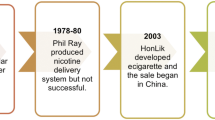Abstract
OBJECTIVES: The goal of this study was to examine the prevalence and perceptions of electronic cigarette use among Canadian youth and young adults.
METHODS: A sample of 1,188 youth and young adults age 16–30 years were recruited from an online panel of Canadians in 2012. After viewing an image of an e-cigarette, respondents answered questions regarding their use and perceptions of e-cigarettes.
RESULTS: Close to half of respondents (43.4%) had seen e-cigarettes advertised or for sale. A total of 1 6.1 % reported trying an e-cigarette (5.2% non-smokers, 1 8.9% former smokers, and 34.5% current smokers), and 5.7% reported use in the past 30 days (0.8% non-smokers, 1.4% former smokers, and 15.0% current smokers). Compared to non-smokers, former smokers and current smokers were more likely to have tried e-cigarettes (OR=4.25 and OR=9.84, respectively), and current smokers were more likely to have tried e-cigarettes than former smokers (OR=2.32). Current smokers were also more likely to be current users of e-cigarettes than both former smokers (OR=15.15) and non-smokers (OR=4.43). Smokers were interested in trying e-cigarettes to help them quit smoking (80.4%), as a long-term replacement for cigarettes (77.8%), or to use in places where they cannot smoke (80.9%).
CONCLUSIONS: Awareness of e-cigarettes among surveyed youth and young adults is quite high. Almost one fifth (16.1 %) of participants reported trying e-cigarettes, with evidence of use among non-smokers.
Résumé
OBJECTIF: L’objectif de cette étude était d’examiner la prévalence de l’utilisation de la cigarette électronique ainsi que sa perception chez les jeunes et les jeunes adultes canadiens.
MÉTHODE: Un échantillon de 1 188 jeunes et jeunes adultes âgés de 16 à 30 ans a été recruté en 2012 à partir d’un panel en ligne de Canadiens. Après avoir visionné une image de e-cigarette, les participants répondaient à des questions relatives à leur utilisation et à leurs perceptions des e-cigarettes.
RÉSULTATS: Quasiment la moitié des participants (43,4 %) avaient déjà vu des e-cigarettes en vente ou des publicités relatives à des e-cigarettes. Un total de 16,1 % ont indiqué avoir déjà essayé la e-cigarette (5,2 % de non-fumeurs, 18,9 % d’anciens fumeurs et 34,5 % de fumeurs), et 5,7 % ont rapporté une utilisation au cours des 30 derniers jours (0,8 % de non-fumeurs, 1,4 % d’anciens fumeurs, et 15,0 % de fumeurs). Les anciens fumeurs et les fumeurs étaient davantage susceptibles d’avoir déjà essayé la e-cigarette (OR=4,25 et OR=9,84, respectivement) par rapport à des non-fumeurs, et les fumeurs étaient davantage susceptibles d’avoir déjà essayé la e-cigarette que des anciens fumeurs (OR=2,32). Les fumeurs étaient également davantage susceptibles d’être des utilisateurs de e-cigarettes que les anciens fumeurs (OR=15,15) ou que les non-fumeurs (OR=4,43). Les fumeurs étaient intéressés par la e-cigarette comme une aide pour arrêter de fumer (80,4 %), comme un substitut à long terme aux cigarettes (77,8 %), ou pour une utilisation dans des lieux non-fumeurs (80,9 %).
CONCLUSIONS: Les e-cigarettes sont relativement bien connues parmi les jeunes et les jeunes adultes interrogés. Quasiment 1 participant sur 5 (16,1 %) rapporte avoir déjà essayé la e-cigarette, avec une utilisation rapportée chez les non-fumeurs.
Similar content being viewed by others
References
Cahn Z, Siegel M. Electronic cigarettes as a harm reduction strategy for tobacco control: A step forward or a repeat of past mistakes? J Public Health Policy 2011;32(1):16–31.
Etter J-F. The Electronic Cigarette: An Alternative to Tobacco? Geneva, Switzerland: Jean-Francois Etter, 2012;1–125.
Non-Smokers’ Rights Association. The Buzz on E-Cigarettes, 2012. Available at: http://www.nsra-adnf.ca/cms/file/files/e-cig%20Brochure%20FINAL.pdf (Accessed February 1, 2013).
Felberbaum M. Marlboro maker Altria jumping into e-cigarettes. Available at: http://bigstory.ap.org/article/marlboro-maker-altria-jumping-e-cigarettes (Accessed June 26, 2013).
Noel JK, Rees VW, Connolly GN. Electronic cigarettes: A new ‘tobacco’ industry? Tobacco Control 2011;20:81.
Ayers JW, Ribisl KM, Brownstein JS. Tracking the rise in popularity of electronic nicotine delivery systems (electronic cigarettes) using search query surveillance. Am J Prev Med 2011;40(4):448–53.
Henningfield JE, Zaatari GS. Electronic nicotine delivery systems: Emerging science foundation for policy. Tobacco Control 2010;19(2):89–90.
Pepper JK, Brewer NT. Electronic nicotine delivery system (electronic cigarette) awareness, use, reactions and beliefs: A systematic review. Tobacco Control 2013;0:1–10. doi: 10.1136.
Etter J, Bullen C. A longitudinal study of electronic cigarette users. Addict Behav 2013, Epub Oct30, doi: 10.1016.
Kralikova E, Novak J, West O, Kmetova A, Hajek P. Do e-cigarettes have the potential to compete with conventional cigarettes? Chest 2013;144(5):1609–14.
Lee S, Grana RA, Glantz SA. Electronic cigarette use among Korean adolescents: A cross-sectional study of market penetration, dual use, and relationship to quit attempts and former smoking. J Adolesc Health 2013, Epub Nov22, doi: 10.1016.
Sutfin EL, McCoy TP, Morrell HER, Hoeppner BB, Wolfson M. Electronic cigarette use by college students. Drug and Alcohol Depend 2013;131:214–21.
Health Canada. Health Canada advises Canadians not to use electronic cigarettes, 2009. Available at: http://www.hc-sc.gc.ca/ahc-asc/media/advisories-avis/_2009/2009_53-eng.php (Accessed March 1, 2013).
Adkison SE, O’Connor RJ, Bansal-Travers M, Hyland A, Borland R, Yong H, et al. Electronic nicotine delivery systems: International Tobacco Control Four-Country Survey. Am J PrevMed 2013;44(3):207–15.
Reid JL, Hammond D, Burkhalter R, Rynard VL, Ahmed R. Tobacco Use in Canada: Patterns and Trends, 2013. Available at: http://www.tobaccoreport.ca/2013/ (Accessed March 22, 2013).
Author information
Authors and Affiliations
Corresponding author
Additional information
Sources of Funding: This research was supported by a grant from the Canadian Cancer Society Research Institute, as well as the Canadian Institutes of Health Research Training Grant in Population Intervention for Chronic Disease Prevention: A Pan-Canadian Program (Grant #: 53893) (Czoli), the Ontario Tobacco Research Unit Ashley Studentship for Research in Tobacco Control (Czoli), the Ontario Graduate Scholarship (Czoli), the Propel Centre for Population Health Impact, a Canadian Institutes of Health Research New Investigator Award (Hammond), and a Canadian Cancer Society Research Institute Junior Investigator Research Award (Hammond).
Conflict of Interest: None to declare.
Rights and permissions
About this article
Cite this article
Czoli, C.D., Hammond, D. & White, C.M. Electronic cigarettes in Canada: Prevalence of use and perceptions among youth and young adults. Can J Public Health 105, e97–e102 (2014). https://doi.org/10.17269/cjph.105.4119
Received:
Accepted:
Published:
Issue Date:
DOI: https://doi.org/10.17269/cjph.105.4119



